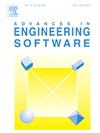A multi-field coupled data-driven surrogate approach for multiphysical damage diagnostic of energy harvesting composite plates
IF 5.7
2区 工程技术
Q2 COMPUTER SCIENCE, INTERDISCIPLINARY APPLICATIONS
引用次数: 0
Abstract
Damage diagnosis in multiferroic composites is essential for energy harvesting systems, where cracking and property degradation significantly impact coupled frequency response and efficiency. This study proposes a multi-field coupled surrogate model for multiphysical damage diagnostics of multiferroic composite plates to address these challenges. These composites exhibit intricate magnetic, electric, and elastic interactions, making damage detection both complex and essential. Unlike traditional finite element updating methods, which are computationally intensive and iterative, the proposed 1DC-BiGRU model offers a more efficient and scalable data-driven alternative. This model integrates convolutional neural networks (CNNs) to extract critical spatial features and Bidirectional Gated Recurrent Units (BiGRUs) to capture complex feature relationships. This architecture excels in processing frequency and mode shape data, enabling robust identification of multiphysical damage patterns. Convolutional layers efficiently reduce data dimensionality while identifying interactions between features. BiGRUs handle relationships between features in a bidirectional manner, mitigating issues like vanishing gradients seen in traditional neural networks. Trained on simulated data generated from Chebyshev finite element analysis and multi-scale plate theory, the model accurately diagnoses damage locations and severities under various scenarios, including both noise-free and noisy conditions. By providing an efficient and robust framework for multiphysical damage detection, this study significantly advances structural health monitoring for multiferroic composite structures.
能量收集复合材料板多物理损伤诊断的多场耦合数据驱动替代方法
多铁复合材料的损伤诊断对于能量收集系统至关重要,其中裂纹和性能退化会显著影响耦合频率响应和效率。为了解决这些问题,本研究提出了一种多场耦合替代模型,用于多铁性复合材料板的多物理损伤诊断。这些复合材料表现出复杂的磁、电和弹性相互作用,使得损伤检测既复杂又必要。与传统的计算密集型和迭代的有限元更新方法不同,本文提出的1DC-BiGRU模型提供了一种更高效、可扩展的数据驱动替代方案。该模型集成了卷积神经网络(cnn)提取关键空间特征和双向门控循环单元(BiGRUs)捕捉复杂特征关系。该体系结构在处理频率和模态振型数据方面表现出色,能够实现多物理损伤模式的鲁棒识别。卷积层有效地降低数据维数,同时识别特征之间的相互作用。BiGRUs以双向方式处理特征之间的关系,减轻了传统神经网络中出现的梯度消失等问题。该模型基于切比雪夫有限元分析和多尺度板理论生成的模拟数据进行训练,可以在各种情况下(包括无噪声和有噪声条件下)准确诊断损伤位置和严重程度。该研究为多铁复合材料结构的健康监测提供了一个高效、稳健的多物理损伤检测框架。
本文章由计算机程序翻译,如有差异,请以英文原文为准。
求助全文
约1分钟内获得全文
求助全文
来源期刊

Advances in Engineering Software
工程技术-计算机:跨学科应用
CiteScore
7.70
自引率
4.20%
发文量
169
审稿时长
37 days
期刊介绍:
The objective of this journal is to communicate recent and projected advances in computer-based engineering techniques. The fields covered include mechanical, aerospace, civil and environmental engineering, with an emphasis on research and development leading to practical problem-solving.
The scope of the journal includes:
• Innovative computational strategies and numerical algorithms for large-scale engineering problems
• Analysis and simulation techniques and systems
• Model and mesh generation
• Control of the accuracy, stability and efficiency of computational process
• Exploitation of new computing environments (eg distributed hetergeneous and collaborative computing)
• Advanced visualization techniques, virtual environments and prototyping
• Applications of AI, knowledge-based systems, computational intelligence, including fuzzy logic, neural networks and evolutionary computations
• Application of object-oriented technology to engineering problems
• Intelligent human computer interfaces
• Design automation, multidisciplinary design and optimization
• CAD, CAE and integrated process and product development systems
• Quality and reliability.
 求助内容:
求助内容: 应助结果提醒方式:
应助结果提醒方式:


